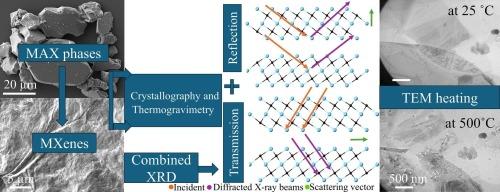Influence of synthesis routes on oxygen content, crystallography, and thermal stability of Ti3AlC2 MAX phases and resulting MXenes
IF 7.9
2区 材料科学
Q1 MATERIALS SCIENCE, MULTIDISCIPLINARY
引用次数: 0
Abstract
Current MXene research focuses on synthesising high-quality MAX phases with minimal O substitution in the C sublattice. This study provides insights into how different ball milling techniques and elemental compositions used in Ti3AlC2 MAX phase synthesis affect the O incorporation into the lattice structure, which directly impacts the MAX phases’ and the resulting MXenes’ thermal stability. The unit cell lattice parameters (LPs) of a MAX phase are well-established indicators in determining the degree of O substitution. The presence of O reduced the a and c LPs of the MAX phase unit cell. However, the corresponding MXenes exhibited similar a LP (a = 3.05 Å) values regardless of the LP values of their MAX phases. The LP observations are validated by correlative thermogravimetric analysis (TGA) carried out in air atmosphere. With the decreasing O incorporation in the MAX phase, an increase in the oxidation temperature was observed from 450 °C to 780 °C. However, the corresponding MXenes showed an average oxidation onset around 460 °C. Thus, this study reveals an important structure–property relationship between the Ti3AlC2 MAX phase and the resulting Ti3C2 MXenes.

合成路线对Ti3AlC2 MAX相氧含量、结晶学和热稳定性的影响
目前的MXene研究主要集中在合成C亚晶格中O取代最小的高质量MAX相。该研究揭示了不同的球磨技术和元素组成对Ti3AlC2 MAX相合成中O掺杂到晶格结构中的影响,从而直接影响到MAX相和MXenes的热稳定性。MAX相的单位晶格参数(lp)是确定O取代程度的公认指标。O的存在降低了MAX相单元细胞的a和c LPs。然而,无论其MAX相的LP值如何,相应的MXenes具有相似的LP值(a = 3.05 Å)。在大气中进行的相关热重分析(TGA)验证了LP观测结果。随着MAX相中O掺入量的减少,氧化温度从450℃升高到780℃。然而,相应的MXenes在460°C左右显示平均氧化开始。因此,本研究揭示了Ti3AlC2 MAX相与所得Ti3C2 MXenes之间的重要结构-性能关系。
本文章由计算机程序翻译,如有差异,请以英文原文为准。
求助全文
约1分钟内获得全文
求助全文
来源期刊

Materials & Design
Engineering-Mechanical Engineering
CiteScore
14.30
自引率
7.10%
发文量
1028
审稿时长
85 days
期刊介绍:
Materials and Design is a multi-disciplinary journal that publishes original research reports, review articles, and express communications. The journal focuses on studying the structure and properties of inorganic and organic materials, advancements in synthesis, processing, characterization, and testing, the design of materials and engineering systems, and their applications in technology. It aims to bring together various aspects of materials science, engineering, physics, and chemistry.
The journal explores themes ranging from materials to design and aims to reveal the connections between natural and artificial materials, as well as experiment and modeling. Manuscripts submitted to Materials and Design should contain elements of discovery and surprise, as they often contribute new insights into the architecture and function of matter.
 求助内容:
求助内容: 应助结果提醒方式:
应助结果提醒方式:


